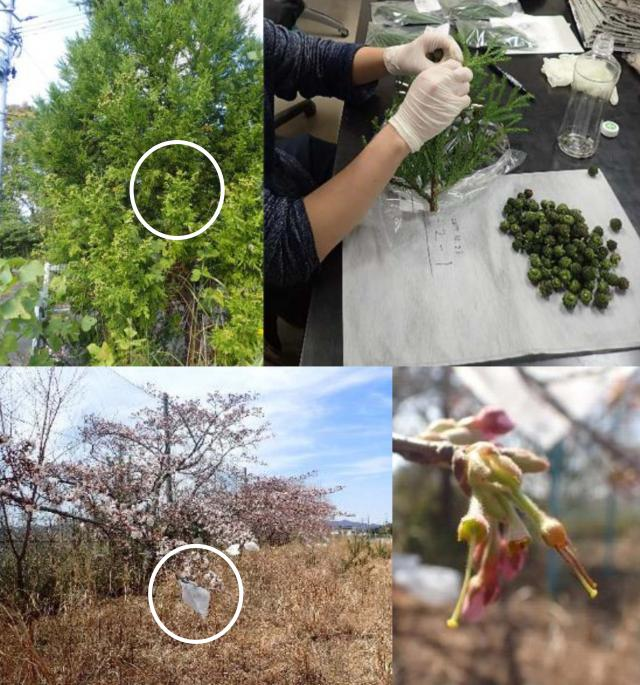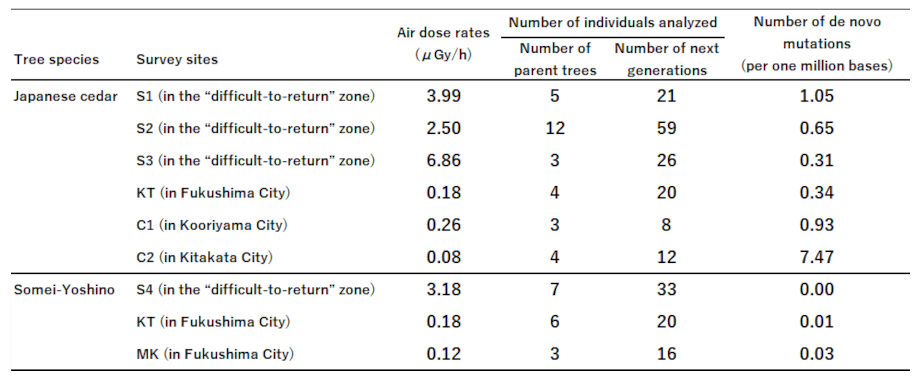Radioactivity Dynamics in forests
(2024)
QDid low-dose radiation exposure in Fukushima prefecture affect de novo mutations of the next generation of trees?
AA study group led by the Forestry and Forest Products Research Institute and Fukushima University developed a method of promptly detecting DNA “mutations1)” that may be a hereditary risk.
Based on this technique, by collecting seeds and seedlings from the parent trees of Japanese cedar (sugi) and flowering cherry (sakura), including individuals grown in the “difficult-to-return” zone in Fukushima prefecture, de novo mutations that had occurred in the next generation were assessed with a reduced genome analysis2). The result showed that low-dose radiation exposure3) due to the Fukushima Daiichi nuclear power plant accident did not increase de novo mutations in the next generation of trees. (Ueno et al. 2022)

Photo 1: Female and male flowers of Japanese cedar and cherry blossoms (“Somei-Yoshino”)
They were suitable as the study subject because they have been planted all over Japan, their sampling methods of artificial seeds have been established and their genetic data has been accumulated.
Study Background
Spread of radioactive materials caused by the Chernobyl and TEPCO’s Fukushima Daiichi nuclear power plant accidents increased air dose rates regionally. Effects of radiation exposure caused by the Fukushima Daiichi nuclear disaster on many plants are not observed but it has been reported that coniferous trees such as the Japanese red pine and fir have shown abnormal branching. For the effects of radiation exposure on organisms, there are concerns about the presence or absence of increase in DNA mutations and hereditary risks caused by the transmission of such mutations to the next generations. When the effects of radiation exposure are not hereditary, there will be no impact on generations germinated after a decline in the amount of exposure. However, when it is hereditary and it is passed down to the next generation, the impact will linger much longer in the next generations.
As to the relationship between radiation exposure in plants and DNA de nuevo mutations in the next generation, there are study findings from an irradiation laboratory experiment on a model plant called Arabidopsis thaliana. It is revealed that a substantial amount of radiation is needed to significantly increase mutations, and that the reproductive stage when seeds are produced is largely affected. (Hirao et al. 2022). Though they are trees grown in the “difficult-to-return” zone in Fukushima prefecture, compared to the amount of radiation in the irradiation experiment, they are exposed to a significantly lesser amount of radiation. Based on these findings, it is considered that the possibility of hereditary risks occurring in the next generations of trees is small. However, since there was no method to detect de novo mutations in trees widely growing in the field, demonstration data was not available to answer the question of, “is there really no increase in mutations in trees in the “difficult-to-return” zone?”.
Therefore, in this study, a technique has been developed to detect DNA mutations that may be hereditary risks in trees naturally growing in the field. For Japanese cedar and flowering cherry (Somei-Yoshio), seeds and seedlings were collected from the parent trees including individuals growing in the “difficult-to-return” zone in Fukushima prefecture, and with the reduced genome analysis2), hereditary risks were assessed by comparing the DNA base sequences to detect different bases (de novo mutations) between the offspring and the parent tree.

Photo 2: Cones (upper right) sampled from the branches of parent tree of Japanese cedar studied (upper left, circled in white), branches of “Somei-Yoshio” during artificial crossing (lower left, circled in white) and “Somei-Yoshio” from which stamens were removed for artificial crossing (lower right), filmed at the survey sites in the “difficult-to-return” zone in 2018 and 2019.
Study Methods
For this study, in 2018 and 2019, 146 seeds were collected from 31 Japanese cedar individuals and 69 seeds and seedlings were collected from 16 Japanese flowering cherry individuals outside the “difficult-to-return” zone, and differences in the offspring base sequences from their parent individuals were investigated. With the reduced genome analysis called the RADseq (restriction site-associated DNA sequencing) technique, for a total of about 170 million bases in Japanese cedars, and 210 million bases in Japanese flowering cherry, their sequences were compared between the parent individuals and the next generation.
●Why Japanese cedar and flowering cherry (“Somei-Yoshino”)?
It is known that conifers are susceptible to the effects of radiation, as morphological variation due to relatively low-dose exposure has been observed. The study subject, Japanese cedar, is a tree species for which research on its ecology and genetic information is most accumulated among conifers. Making the most of the accumulation of research, it became possible to smoothly collect samples and perform DNA analysis and data analysis.
Japanese flowering cherry (“Somei-Yoshino”) has been clonally spread from a single parent tree, which can be a major research advantage. “Somei-Yoshio” is a popular variety planted over a wide area in Japan, and it is known to be an identical clone propagated by cutting. Their mutation probability is generally very low, therefore, it is necessary to compare a huge number of bases for the evaluation. When a clone from a single parent tree is grown in various places, such as “Somei-Yoshino”, there is no need to consider genetic differences of parent trees in data analysis, which significantly reduces the time and effort required for data analysis.
Study results
As a result of the analysis, in both Japanese cedar and flowering cherry, the effects of individual environments such as locations where seeds were collected and branches were confirmed on the presence or absence of mutations, however, the effects related to radiation exposure such as air dose rates and the amount of radioactive cesium accumulated were not found (Table). For example, regarding the estimated mutation detection frequency in Japanese cedar, at the S3 survey site where the air dose rate was the highest, it was 0.31 per million bases, however, it was 7.47 per one million bases at the survey site in Kitakata City where the air dose rate was the lowest (Table). It is revealed that mutation rates in Japanese cedar vary depending on the locations of growth and branches, but the number of mutations did not increase only in the “difficult-to-return” zone. For Japanese flowering cherry, as to seeds obtained from the parent tree growing in the environment where the air dose rate was 3.18 μGy/h during the survey, although a total of 108 million bases were investigated, de novo mutations were not observed.
Table Air dose rates and number of de novo mutations at the survey sites
Significance of the study
When explaining risks of radiation exposure, data that “no mutations occurred” in the “difficult-to-return” zone can be valuable basic data. There seem to be many citizens who still feel that a small amount of exposure to radiation will surely lead to adverse effects. This may be related to the fact that understanding stochastic effects is difficult and with radiation irradiation experiments, there are many reports about examples of changes that had occurred. Data that “no change occurred” has been rarely released up to now, and it is expected that such data will be used as effective basic data in removing fear on the radiation impact and dealing with rumor-induced damage to agriculture and marine products produced in Fukushima prefecture.
- Ueno, S., Hasegawa, Y., Kato, S., Mori, H., Tsukada, H., Ohira, H., & Kaneko, S. (2023). Rapid survey of de novo mutations in naturally growing tree species following the March 2011 disaster in Fukushima: The effect of low-dose-rate radiation. Environment International, 174, 107893. (https://www.sciencedirect.com/science/
article/pii/S0160412023001666) - Hirao, A. S., Watanabe, Y., Hasegawa, Y., Takagi, T., Ueno, S., & Kaneko, S. (2022). Mutational effects of chronic gamma radiation throughout the life cycle of Arabidopsis thaliana: Insight into radiosensitivity in the reproductive stage. Science of The Total Environment, 838, 156224.(https://www.sciencedirect.com/science/
article/pii/S0048969722033216)
Notes;
- 1)Mutation:
Genetic information (DNA) is accurately passed down from the parental generation to the next generation through eggs and pollen, but in rare cases, information different from that of the parental generation is transmitted, which is called a “mutation”. Mutation is a mechanism necessary for organisms to obtain genetic diversity and it is known that exposure to high levels of radiation makes mutation more likely. - 2)Reduced genome analysis:
It is a technique to analyze whole genome characteristics by selecting a region with specific sequences from the entire genome area. It is unclear where de novo mutations will occur in the DNA base sequence that makes up huge genomes. To find that out, investigating the whole genomes of target individuals would be ideally desirable. However, except for model plants such as Arabidopsis thaliana, which have relatively few bases constituting their genome, it is impractical to investigate the whole genome of many individuals for comparison using current analysis and data analysis technologies. Therefore, by focusing only on a region with specific sequences, comparison between many samples becomes possible, as conducted in this study. Although particular attention is paid to some regions in the genome, the latest equipment makes it possible to analyze vast amounts of base sequences, thus, de novo mutations can be detected as was the case in this study. - 3)Low-dose radiation exposure:
It has been known since ancient times that a high level of radiation can cause mutations in base sequences of organisms. However, the effects of mutation resulting from low-dose of radiation exposure are not well understood because of low mutation frequency and the function of organisms to repair the mutation that occurred. In the “difficult-to-return” zone in Fukushima Prefecture, the air dose rate increased after the accident, but it is still less than a few thousandths of the dose rate that has been experimentally confirmed to increase mutation. Such assessment of the presence or absence of mutation resulted from the low-dose exposure and hereditary risks has become an important research topic for managing risks after a nuclear power disaster as well as for space development.
(Reproduced (partially revised) from the press release of the Fukushima University and Forestry and Forest Products Research Institute)
Related articles
- Will cesium distribution in forests continue to change in the future?
- What kind of changes did radioactive cesium concentrations in wood and bark of trees contaminated by the nuclear accident go through over 10 years since the accident?
- Do radioactive cesium concentrations in trees change season to season?
- Is the downward migration of radioactive cesium in forest soils in Japan after the Fukushima accident any different from the movement of radioactive cesium around Chernobyl after the Chernobyl disaster?
